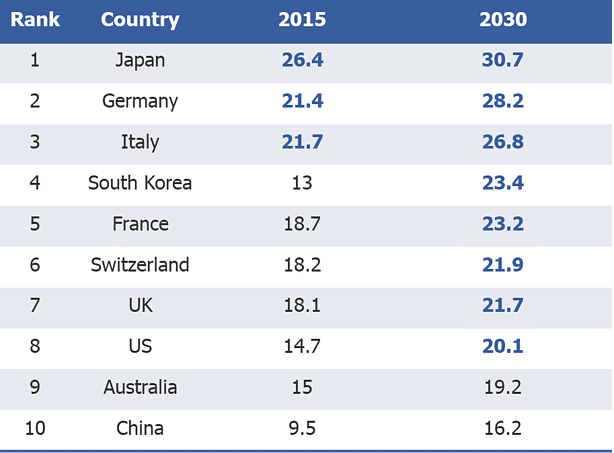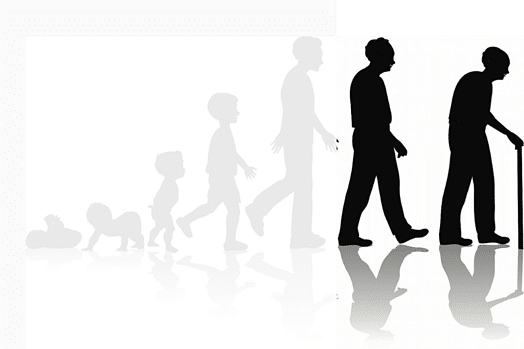There are probably only a few things in the world today that we can say we are certain will happen. Aging is one of them.
At our recent Lux Executive Briefing in Tokyo, Japan we shared how digital technologies are providing new ways to support an aging demographic, providing near term business opportunities. A rapidly aging demographic is affecting most developed economies today (Figure 1). This is driven by a combination of declining fertility rates and rising life expectancy. But with all the news around aging and the somewhat negative spin put on it, it is important to first revisit the concept of aging.

Figure 1: Percentage of population aged 65 years or older. A nation with more than 20% of its population aged 65 years of older is consider a ‘super-aged’ society by Moody’s. As of 2015, three nations: Japan, Germany and Italy have already reached this milestone, and by 2030, its predicted that another five countries will join in, including the US. The elderly demographic is clearly a growing market segment, that also presents near term business opportunities. | Data source: Financial Times
Aging is a natural process of life, much like infancy, adolescence and puberty. While many companies seem to focus on slowing down or defying aging, there is relatively less buzz around supporting healthy and graceful aging-in-place. This is interesting as most of our understanding of the molecular biology of aging is still at research stage, led by centers like the Buck Institute of Aging. There are cosmetic products with topical applications that have anti-wrinkling properties that may make claims to slow down aging, but while they may support a more youthful appearance, the internal aging processes within the body are not changed. Other claims around herbal remedies and supplements are largely anecdotal, without rigorous and reproducible scientific validation in humans to support such links. Hence any opportunity to slow down aging holistically is at best a long-term opportunity.

However, aging-in-place solutions look to support graceful and comfortable aging in familiar surroundings with near term opportunities. These solutions accept aging for what it is, and instead look to offer solutions to enhance quality of life for healthy senior citizens and to help support healthier living for those whose health state has started to deteriorate. There are at least five different digital technologies today that are already finding use cases to support aging-in-place:
Wearable devices – Wearable devices are arguably the most mainstream of digital health tools today. Wearable devices can play a big role for elderly care as well. A few developers today have looked at customizing wearables to specifically support the elderly market. GoLiveClip by Gociety Solutions is a smart clip, a convenient form factor that can be clipped anywhere, on the collar, on the buttons or the belt. It sounds the alarm when an individual falls and alerts family members and caregivers, but also is predictive as it analyses walking pattern and sends an alert when fall risk increases. But a wearable can go beyond a smartwatch or a smart clip. AWAK Technologies for an instance has developed a wearable dialysis device, which has received the US FDA Breakthrough Device Designation. A typical challenge in kidney dialysis is a need to book an appointment, wait for a slot, visit a dialysis center and when dialysis happens, the individual is immobilized. A portable, wearable dialysis device offers the convenience of performing dialysis on demand and individuals can go about their daily routine as per normal as the dialysis takes place.
Smart textiles – Smart textiles can track various parameters in an everyday form factor. A challenge with wearable devices is that if they are not used or worn, then the intended benefits will not be realized. This is particularly so for the elderly who may find it inconvenient to put on a bulky or inconvenient form factor. For those facing mental decline or early stages of dementia, the chances of forgetting to put on the device increases. Clothes on the other hand is a necessity, and hence embedding biosensors within the textiles themselves is a good way to support a higher retention rate. While smart textile developers are typically agnostic to the age segment of their end consumer, the technology helps to detect signs that suggests if there is deviation from normal activity. Take Sensing Tex, a developer of textiles embedded with pressure sensors that maps onto an external software. Their technology is used in hospital beds to detect abnormal positions and falls. Sensoria develops smart socks for medical monitoring purposes for rehabilitation after an accident or stroke. Both these technologies can clearly be further customized to support aging-in-place solutions at home as well, where the beds could be re-purposed with pressure sensors that help alert any deviation from a normal sleeping position combined with garments that continuously track vitals.
Virtual reality (VR) – VR today is mostly used for games. In seniors however, VR is seeing use cases in support emotional well-being and even helping manage dementia. Rendever specifically builds VR headsets for senior citizens both at homes and retirement and assisted living communities. The experience transports the wearers to different locations and provides new experiences for those with limited mobility. Tribemix uses VR instead for cognitive stimulation and training to help dementia patients.

Photo Source: Rendever
Robotics – Consumer robotics is still early stage today. However, we’re starting to see medical exoskeletons gaining approval for home use to rehabilitate those recovering from accidents or stroke. Medical exoskeletons and prosthetics could enhance mobility and independence, allowing seniors to enjoy a quality of life they couldn’t experience previously. But robotics can go beyond physical activity, with companies like Softbank Robotics working on developing social robots for companionship. However, this strategy presents challenges. It is tough to get humans to develop a connection with a robot the same way one would with a human being – but this trend could change
Artificial Intelligence (AI) – AI powers the data analytics in the technologies above, but AI on its own could function as a diagnostic and therapeutic tool. An example is the use of speech recognition for early dementia detection using Natural Language Processing (NLP). The technology can identify speech patterns correlated with early stage dementia, providing a means for a ‘digital biomarker’. Digital therapeutics is another area that’s poised to take off, with the FDA clearing a couple of therapeutics in this category already. Both these diagnostic and therapeutic tools are software-only, powered by AI.
These are just some technologies that are finding use cases today to support the aging demographic. A typical assumption is that opportunities here are only open to healthcare players. However, the rise of digital natives and tech giants like Google, Apple and Amazon developing new healthcare products has challenged this notion. Printed electronics, sensors and material developers are just a few industries that could also find new business opportunities here as they bring in capabilities to support more durable, lightweight and powerful form factors to support the ageing demographic.
Ultimately to map out business opportunities, it is also critical to understand where along the health state (for example, pre-disease or severely diseased) the technology is applicable and how else can the technology be modified or expanded to address other health states. This can be used for the elderly demographic, but also, in theory, for any other demographic or disease. We put this framework to action in our recent report on diabetes care. For more information about the framework, please get in touch.
